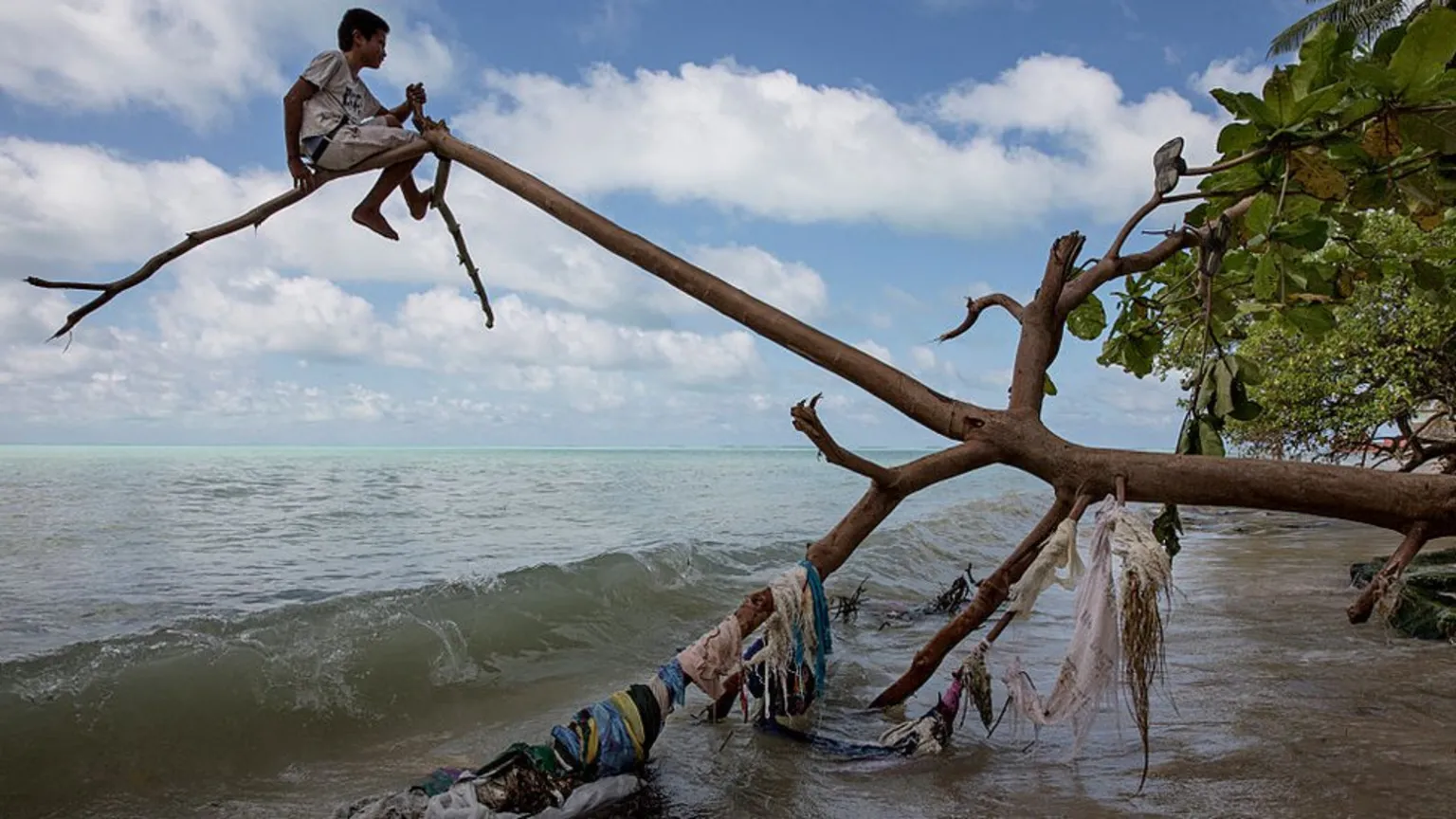By Mostafa Mahmud Naser
This blog post is adapted from the author’s presentation at the 10th Biennial Conference of the Asian Society of International Law in Hanoi, Vietnam from 9 to 10 October 2025.
Introduction
Climate change and modern slavery may seem like unrelated issues – one about weather patterns and ecosystems, the other about crime and human rights. Yet in Australia, these challenges are becoming increasingly intertwined. As climate impacts intensify across the Pacific, more people are being displaced and moving under precarious conditions that increase their vulnerability to exploitation and abuse.
The World Bank (2021) estimates that climate change could displace more than 200 million people by 2050. For low-lying Pacific Island nations, such as Kiribati, Tuvalu, Fiji, and Vanuatu, rising sea levels and intensifying storms pose a significant threat to the very habitability of their lands. The deterioration of traditional livelihoods is expected to drive migration to neighbouring countries, especially Australia, as an adaptive response.
However, Australia’s migration system offers no formal legal status for people displaced by climate change. These individuals fall outside the narrow refugee definition under the 1951 Refugee Convention, which requires persecution on specific grounds such as race or religion. Those displaced by environmental degradation instead must navigate temporary labour schemes or informal channels, often without sufficient protection.
This legal vacuum leaves many migrants precariously positioned, trapped in cycles of debt, exploitation, and, in the worst cases, modern slavery. Understanding how climate change, migration, and exploitation interact in the Australian context is therefore essential for developing humane, future-focused policy responses.
The Legal Blind Spot: Climate-related Mobility without Recognition
International law has been slow to adapt to climate-related human mobility. The 1951 Refugee Convention and its 1967 Protocol, cornerstones of Australia’s refugee policy, do not recognise environmental harm as a ground for protection. The UN Human Rights Committee’s 2020 views marked a significant development, suggesting that deporting individuals to climate-affected regions could, in extreme cases, infringe upon the right to life under international law. It also underscored that states must avoid returning individuals to environments where climate change poses serious risks to their lives or dignity.
Despite such developments, Australian law remains silent on climate-related human mobility. The Migration Act 1958 (Cth) mirrors the Convention’s restrictive definitions, offering no protection for people forced to migrate due to environmental or climatic factors. Scholars have repeatedly highlighted this “protection gap.”
A 2023 review of Australia’s migration system, led by former public service chief Martin Parkinson, cautioned that climate displacement is “becoming a reality in our neighbourhood.” The report urged the Australian Government to proactively engage with Pacific governments to develop coordinated responses, including creating safe and accessible migration pathways for the most vulnerable communities. By 2050, sea-level rise and resource scarcity are expected to trigger significant cross-border movements, especially from Australia’s Pacific neighbours.
Irregular Migration and the Risks of Exploitation
Because persons displaced due to climatic impacts are not formally recognised under Australian immigration law, many are likely to resort to precarious migration pathways. Some may arrive on short-term or seasonal worker visas, others overstay, and a few move through informal networks. These pathways often blur the line between regular and irregular migration, and when not well regulated, they expose people to serious exploitation.
A key channel has been the Pacific Australia Labour Mobility (PALM) scheme, which allows Pacific and Timor-Leste citizens to work in sectors like agriculture, meat processing, and hospitality. While the program offers vital income opportunities for climate-affected communities, it has also produced alarming cases of abuse. Under current rules, PALM workers are typically tied to a single employer and cannot change jobs easily. This dependency leaves them vulnerable to wage theft, unsafe conditions, and coercion. Those who leave abusive employers lose their visas and entitlements, effectively becoming undocumented.
Reports from regional towns reveal hundreds of “disengaged” PALM workers living rough after fleeing exploitation, with some earning as little as $200 a week for gruelling work. Without legal status, many resort to informal labour, where unscrupulous employers exploit their fear of deportation. The NSW Anti-Slavery Commissioner’s 2024 report warned that hundreds, possibly thousands, of temporary migrant workers face debt bondage, servitude, and trafficking risks.
The danger extends beyond farms. Domestic work and hospitality, often hidden from public view, have seen similar abuses. In one landmark case, a Fijian woman held on an expired visa was enslaved as a housekeeper in Brisbane for eight years.
Ultimately, the absence of legal recognition for climate-related human mobility forces many into irregular or tied labour arrangements. These systemic gaps leave climate migrants trapped between survival and exploitation, highlighting an urgent need for humane, rights-based migration reform.
Policy Gaps at the Nexus of Migration and Modern Slavery
Australia has robust laws against slavery and trafficking. The Criminal Code Act 1995 (Cth) criminalises forced labor, servitude, and deceptive recruitment, while the 2018 Modern Slavery Act requires large companies to report on supply chain risks.
Yet enforcement remains weak. Victims rarely come forward due to fear of deportation or mistrust of authorities. Reporting obligations for corporations lack penalties, and the link between migration policy and labour exploitation is poorly addressed.
In practice, Australia’s policies on migration, modern slavery, and climate change tend to operate separately, with limited coordination across these areas. As a result, people displaced by climate impacts can face gaps in protection, often falling outside refugee and migration frameworks, constrained by visa rules, or lacking adequate support when they experience exploitation.
Emerging Pathways: Steady Progress Toward Inclusion
Australia has taken limited steps that indirectly relate to climate-related human mobility. In 2024, the Falepili Union treaty with Tuvalu introduced a special mobility pathway, allowing up to 280 Tuvaluans per year (around 2.5% of Tuvalu’s population) to live, work, or study in Australia. Similarly, the Pacific Engagement Visa (PEV) scheme, launched in 2023, offers 3,000 permanent residency places annually for citizens of Pacific Island countries and Timor-Leste. Although not explicitly climate-focused, the program responds to broader regional and developmental pressures, including those linked to environmental change. These initiatives represent modest progress but remain narrow in scope. Without broader policy reform, many climate-affected people will continue to rely on temporary labour programs or irregular migration channels, both of which increase the risk of exploitation.
Towards a Rights-Based, Human-Centered Response
To respond effectively to these interconnected challenges, Australia would benefit from a more coordinated and rights-based approach. Several practical reforms could help strengthen policy and promote a more preventive and forward-looking approach.
1. Recognise Climate Displacement in Migration Frameworks
Australia should formally acknowledge climate change as a driver of displacement and create dedicated migration pathways for affected communities. A “Climate Humanitarian Visa,” modelled on the Tuvalu Falepili agreement, could offer relocation options for vulnerable Pacific nations. Integrating climate considerations into the Pacific Engagement Visa and humanitarian programs would demonstrate leadership and solidarity in addressing climate mobility.
2. Fairer Pacific Partnership: Reforming Labor Mobility for Mutual Benefit
As many Pacific Islanders continue to work in Australia, reforming labour mobility schemes is essential to prevent exploitation. The PALM program should adopt a “dignity and decent work” principle, allowing job mobility, enforcing labour hire licensing, ensuring safe housing and healthcare access, and improving oversight, to transform Australia’s Pacific labour engagement into a genuinely fair partnership.
3. Invest in Climate Adaptation and Regional Resilience
Addressing root causes is as important as treating symptoms. Australia should expand support for climate adaptation in Pacific nations through investments in coastal protection, freshwater security, and livelihoods in renewable energy, fisheries, and tourism. Strengthening resilience reduces forced displacement and unsafe migration. Regional cooperation under the Pacific Islands Forum’s Framework on Climate Mobility offers a pathway for planned, rights-based migration. Australia, alongside New Zealand, can help operationalise this framework and embed education, skills training, and anti-trafficking safeguards within future mobility agreements.
4. Center Human Rights and Survivor Voices in Policy Making
A rights-based approach requires that those most affected, climate migrants and survivors of exploitation, have a genuine voice in shaping solutions. Australia should engage Pacific communities, civil society, and survivor networks to ensure policies reflect lived realities. As McAdam and Pryke (2020) note, most Pacific Islanders wish to remain at home, yet mobility planning is essential. Migration must be framed as mutual solidarity, not charity.
Conclusion
Climate change is reshaping the human landscape of the Pacific. As environmental pressures mount, mobility will increase, but whether that migration occurs safely or exploitatively depends on the policies Australia adopts today.
Creating orderly, dignified migration pathways is not only a moral imperative but also a strategic one. It fosters regional stability, upholds labour standards, and reinforces Australia’s reputation as a rights-respecting nation.
Failing to act risks perpetuating cycles of displacement, exploitation, and injustice. By bridging the gap between climate, migration, and human rights policy, Australia can transform a looming challenge into an opportunity for justice and regional solidarity, setting an example for the world in this new era of entangled vulnerabilities.
About the author
Dr Mostafa M Naser is a Lecturer in Law at Edith Cowan University (ECU); Mostafa is a Vice-President of the Asian Society of International Law (AsianSIL) and Co-Chair, AsianSIL Interest Group on International Environmental Law.
Image credit: Getty Images





